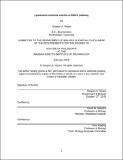Lysosomal nutrients and the mTORC1 pathway
Author(s)
Wyant, Gregory A.(Gregory Andrew)
Download1102637332-MIT.pdf (25.15Mb)
Other Contributors
Massachusetts Institute of Technology. Department of Biology.
Advisor
David M. Sabatini.
Terms of use
Metadata
Show full item recordAbstract
The lysosome is the major catabolic organelle, is the site of activation of the master growth regulator mTORC1 (mechanistic target of rapamycin (mTOR) complex 1), and is often deregulated in common diseases, such as cancer. Given the critical role of lysosomes in maintaining cellular homeostasis, a better understanding of lysosomal function and metabolism and its relation to the mTOR pathway is necessary. Most components of the nutrient-sensing machinery upstream of mTORC1 localize to the lysosomal surface, and amino acids generated by lysosomes regulate mTORC1 by promoting its translocation there, a key step in its activation. Activation of mTORC1 by the amino acid arginine requires SLC38A9, a poorly understood lysosomal membrane protein with homology to amino acid transporters. To study SLC38A9 function at the lysosome, we developed a novel method for the rapid isolation of intact mammalian lysosomes suitable for metabolite profiling. First, we validate that SLC38A9 is an arginine sensor for the mTORC1 pathway, and we uncover a central role for SLC38A9 in amino acid homeostasis. SLC38A9 mediates the transport, in an arginine-regulated fashion, of many essential amino acids out of lysosomes to be used in growth-promoting processes. Pancreatic cancer cells, which use lysosomal protein degradation as a nutrient source, require SLC38A9 to form tumors. Thus, through SLC38A9, arginine acts a lysosomal messenger to connect mTORC1 activation and the release of the essential amino acids to drive cell growth. Finally, by performing quantitative proteomic analyses of rapidly isolated lysosomes, we find that ribosome degradation provides the lysosomal arginine that promotes SLC38A9 activation. Lysosome degradation of ribosomes is mediated by NUFIP1 (nuclear fragile X mental retardation-interacting protein 1). The starvation-induced degradation of ribosomes via autophagy (ribophagy) depends on the capacity of NUFIP1 to bind LC3B and promotes cell survival. Thus, the NUFIP1-mediated degradation of ribosomes provides both the necessary substrate to activate SLC38A9 and the nutrients needed to promote cell survival under starvation. Altogether, this work provides insight into the regulation of lysosomal nutrients and their role in cellular growth and survival.
Description
This electronic version was submitted by the student author. The certified thesis is available in the Institute Archives and Special Collections. Thesis: Ph. D., Massachusetts Institute of Technology, Department of Biology, 2019 Cataloged from student-submitted PDF version of thesis. "February 2019." Includes bibliographical references.
Date issued
2019Department
Massachusetts Institute of Technology. Department of BiologyPublisher
Massachusetts Institute of Technology
Keywords
Biology.